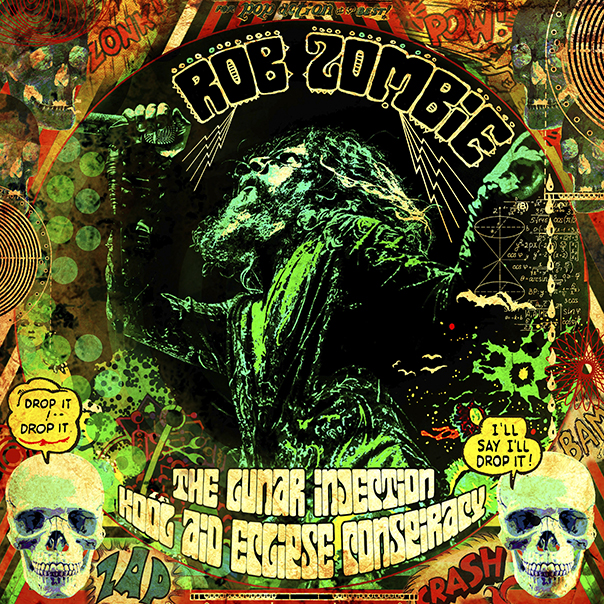Rob Zombie achieves peak self with ‘The Lunar Injection Kool Aid Eclipse Conspiracy’

Rob Zombie has been making music, as part of White Zombie or solo, for 35 years. Even his side gig as a director has lasted for 17 years and eight features.
The Lunar Injection Kool Aid Eclipse Conspiracy
Rob Zombie
Nuclear Blast, March 12
8/10
Like anyone who’s been doing something that long, Zombie—he legally changed his name to “Rob Zombie” in 1996—knows his style: It’s a mix of ’50s and ’60s horror and sci-fi, and ’70s grindhouse themes and imagery, set to grinding metal guitars. It had the overall vibe of a strip club in dystopia. It obviously works for him.
His new album, The Lunar Injection Kool Aid Eclipse Conspiracy, mostly sticks to that template. There are the retro sci-fi sound effects, the references to golden age horror and to “Blacula” and the grindy guitars.
At this point it probably wouldn’t be fair to expect massive innovation, and the reason Rob Zombie sticks with what he knows is because he’s so good at it. Kool Aid Eclipse Conspiracy is, if anything, peak Rob Zombie. It’s the pure, distilled form of his sound. Just about every song could be a single on most of his prior albums; it’s essentially a greatest hits album of new material.
After six short interludes, the first real track is “The Triumph of King Freak (A Crypt of Preservation and Superstition),” which—believe it or not—is not the longest song title on the album. It’s driven by drumming reminiscent of the Doof Warrior from “Mad Max: Fury Road” in its rhythmic intensity and, while not a consistent theme, is a great table-setter.
“The Ballad of Sleazy Rider” is very much more classic Zombie, but with a periodic bluesy guitar riff oddly uncharacteristic of the form. As much as anything can be, since part of the form is auditory curveballs and the occasional cognitive dissonance. Otherwise, it has the trademark guitar tone and steady pacing.
“Shadow of the Cemetery Man” is weirdly indistinguishable from “Sleazy Rider.” Without an interlude between them, it would be a bit tough to tell where one ended and the other began.
After yet another short interlude—this one called “A Brief Static Hum and Then the Radio Blared” because Zombie gave up on brevity of titles about a decade ago—we get to both the least conventional song on the album and the official longest title: “18th Century Cannibals, Excitable Morlocks and a One-Way Ticket on the Ghost Train.”
Yes, that is the actual song title of track seven.
It begins as a ’60s-era country song. Considering the artist, one expects it to segue into a metal song, but for the most part it just doesn’t. A couple times the metal guitars kick in and Zombie twice shouts, “Get on board the ghost train!”but then it goes back to being an old-school country song. He periodically switches genres for a verse of a song as part of his theme, to keep listeners on their toes in the same way a horror movie director keeps the audience from getting comfortable. This time, he did it with an entire song.
“The Eternal Struggles of the Howling Man” begins as a very fast song. Not fast in terms of tempo, but in the same sense “Breaking the Law” or “Kickstart My Heart” is fast. By its very nature, it makes you want to drive fast. It’s not an easy thing to pull off and it’s becoming a lost art.
Of course, about two minutes in, it abruptly shifts to a mellow funk groove for 30 seconds or so, then brings back the hard rock while keeping a funky aesthetic. The driving music is fun while it lasts.
The next curveball is “The Much Talked Of Metamorphosis.” It’s a two-minute-long acoustic instrumental with a strummed acoustic guitar behind a picked, Spanish-inspired guitar. No drums or bass. About halfway in it pauses and one expects the metal to return. But no, it’s a genuinely beautiful acoustic guitar duet.
This, of course, leads to a song called “The Satanic Rites of Blacula,” featuring the heaviest, most driving beat of the album. It’s the sort of beat that forces you to head-bang no matter what you’re doing when you hear it. It makes you want to mosh by yourself in your own home, which is not advisable because it leads to damaged furniture.
There’s yet another interlude, then the requisite ’70s inspired songs “Shake Your Ass-Smoke Your Grass” and “Boom-Boom-Boom,” the latter of which has surprisingly sinister undertones reminiscent of Marilyn Manson without the faux-shocking edgelord aesthetic.
One more interlude—there’s six in all—is followed by “Get Loose,” which is another Rob Zombie standard but with a sitar at the beginning and the chorus, which works remarkably well in the flow of the song.
“Crow Killer Blues” closes out the album and is far more melodic death metal than one would expect. It has a lot more in common with Ghost than the traditional Rob Zombie songs, though his vocals are still on-brand. He pulls it off.
It’s a long and winding road through a summation of his styles and influences, and it’s enjoyable all the way through. If you like Rob Zombie you’ll love it, and if you don’t you probably don’t want to hear him in his truest form.
Follow editor Daniel J. Willis at Twitter.com/BayAreaData.
